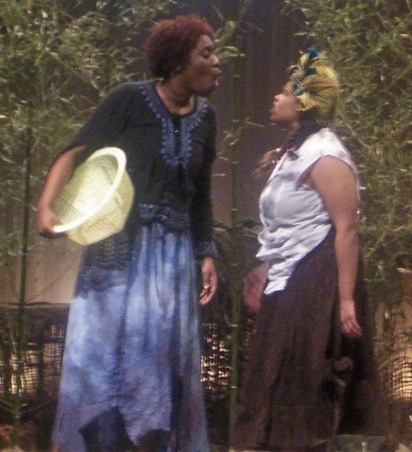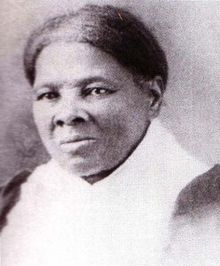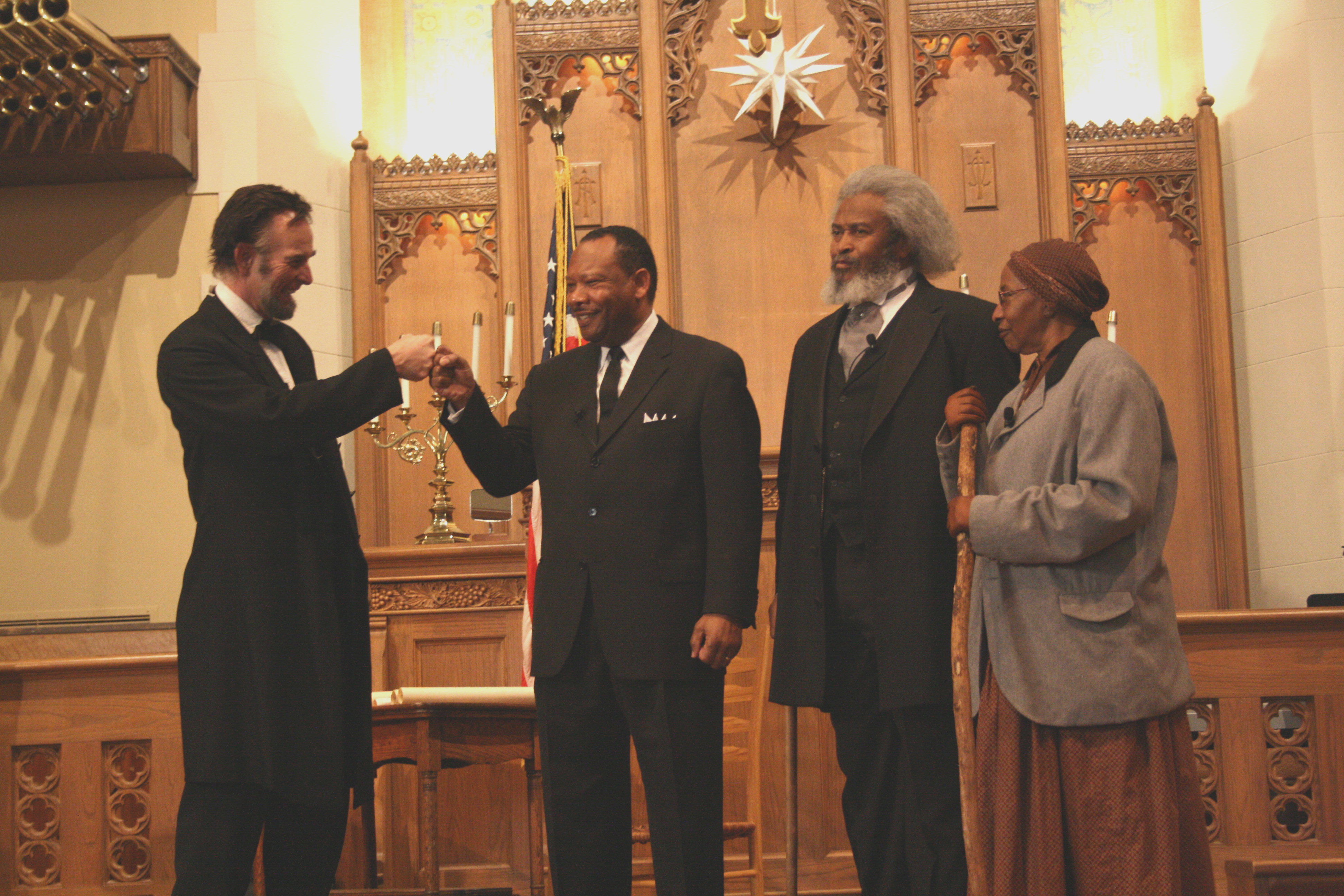Liberation Tour
 Tour America's Liberation with Harriet Tubman
Tour America's Liberation with Harriet TubmanMany are familiar with the underground railroad, however, your time travel living historians Mrs. Tubman and Captain Bartlett will acquaint you with the "other tradition" of inter-racial fellowship and cooperation. Mr. Bartlett was crippled fighting enslavers in the Union Army and still returned as a Captain to lead Self-Liberated Maryland African Descent Americans in Battle against their kidnappers. After the war he was unique in working thereafter to help create the opportunity for fellow USCT veterans to start a city for themselves in the 1890s, a town which is now known as North Brentwood in Maryland. Similarly, Mrs. Tubman, who together with Mr. Frederick Douglass are the key protagonists of this tour will be joining us. These two living historians will travel with you through time to participate in the liberation of 4 million Americans!
 Harriet Tubman
Harriet Tubman
Torrie Musta is an experienced actress who has performed many plays in the Washington DC area. Her roles include Jennifer in Junkanoo and the Lady in Brown in For Colored Girls Who Have Considered Suicide When the Rainbow Is Enuf. If you get a chance to tour the African American Museum of History and Culture please look for the exhibit about that play on the top floor. The Lady in Brown gives an unforgettable ode to the strong inspiration Toussaint L'Ouverture provided to America's imprisoned population just as his participation in America's Revolution inspired and taught him what he needed to know to lead Haiti to be the first peoples on earth to throw off enslavement by their own hand. The Americans of African descent were the second using the USCT to do so! Jennifer provided Torrie another powerful role, depicting self-liberation from enslavement. Torrie brings to her living history portrayal of Harriet Tubman the life experience of her family's own liberation on June 9th 1864, their purchase of the grounds on which they were imprisoned since 1740 in 1905 where they continue to live and celebrate liberty to this day.

 Captain Bartlett
Captain Bartlett
Spilling blood with your fellow soldier was a touchstone moment for so many Americans during the Civil War. Captain Wallace Bartlett was no different. Born in 1844 at Warsaw, New York, he was borng into a strong and early center of abolitionist sentiment. The Warsaw American Antislavery Society formed in 1833; in 1834 the First Congregational Church of Warsaw adopted the resolution that slavery was "repugnant to the principles of the Gospel;" in 1839 the National Liberty Party was founded in Warsaw to advocate for the abolition of slavery. Aside from European Descent leadership for liberty Captain Bartlett was witness to many heroic African Descent Americans who self-liberated from their concentration camps and passedthrough Warsaw a stop on the Underground railroad. The most famous such hero Captain Bartlett would ahve seen in his childhood was Eliza Burghardt who famously escaped enslavement in Maryland to Warsaw to pursue her life in 1849. Such an upbrging led him to Volunteer for the US Army to fight the enslavers in 1862. One African Descent Americans were permitted to fight he recovered from wounds and imprisonment to lead the 19th USCT Regiment, composed of Maryland Self-Liberated from the Eastern Shore. In total six regiments were raised from Maryland. After the war he attended the Washington DC USCT reunion of 1892 and popularized the notion of his selling some of his farm in Prince Georges County Maryland to his Regiment's former soldiers and other USCT Veterans. On September 20, 1892, around 80,000 veterans marched down Pennsylvania Avenue along the same route that the victorious Union Armies had taken in the Grand Review of May 23-24, 1865. African Descent American soldiers, who were excluded from the 1865 review, marched alongside their comrades. In May 2015 Living Historian Lex Musta was able to reenact Captain Bartlett's March in the USCT 19th down Pennsylvania Avenue. Gasaway Hawkins of the 39th USCT and Mr. Woodland of the 9th Regiment USCT were some of the veterans who together founded North Brentwood on Bartlett's former land. An insight into his mind is provided through his 4 published books, the most revelating of which was published the year before he passed away in 1907: "When ye shall bring your legion to embrace all of the human kind. When ye shall raise your weaker brethren to your plane, so ye can join All living men and women in a mighty army, Thinking and acting all in harmony as one, And all in union ... Then shall my purpose be fulfilled. Then shall ye come to be at one with me."
Lex Musta is a professional historian who co-founded the African American Historical Alliance of South Carolina.

 Time Travel Tours Features Living Historians
Time Travel Tours Features Living Historians
Who are "Living Historians?"
The term is applied to anyone who attempts to convey information about the past while dressed in period clothing. The term "re-enactor" is often used in place of living historian. Reenacting is actually a recreational pastime, carried on by individuals with an interest in history. Dressing in period clothing and engaging in period activities allows re-enactors to "experience" the past. Living historians, tend to be associated with museums and historical sites that specialize in interpreting the past through a format that allows visitors to visualize the past through the use of their senses.
What does the term "first person" mean?
The term refers to a technique where a person takes on a historical persona and acts as if he or she was that person. The persona can be that of a well-known historical figure like Harriet Tubman or Frederick Douglass. It can also be of an actual but unknown historical figure like a Captain Wallace Bartlett. A person in true first person mode does not know anything about events or the world outside his or her historical timeframe.
How does living history work?
Living history requires interaction between the interpreter and visitor. This means that the interpreter must draw the time travelers into his or her world. Time travelers should feel free to approach the interpreters with a question.
Interaction can be impromptu or scripted. Impromptu interaction is often driven by a visitor's questions and contains an element of spontaneity. However, most visitors usually have similar questions, allowing the interpreter to give fairly standard answers. Thus, the information being dispensed is consistent. Impromptu interaction works well in small group environments. Scripted interaction works better for large groups because the element of intimacy can be lost when many people of families present. In a scripted scenario, the interpreter addresses the entire group, presenting predetermined information. It, too, can be interactive by encouraging questions from the group or selecting people to participate in the presentation.

Tour Services
Time Travel Reservations
The following departures are available for you and your friends or family:African American History Month Liberation Tour on February 18 2017 from 8am to 4pm EST in Washington DC
Contact Time Travel Tours



